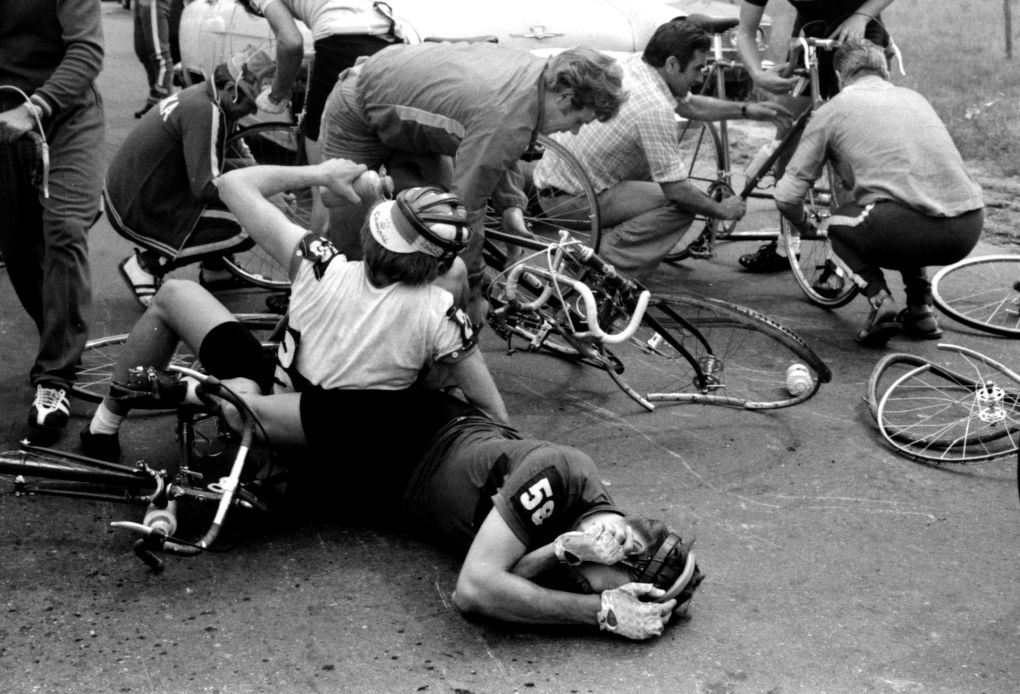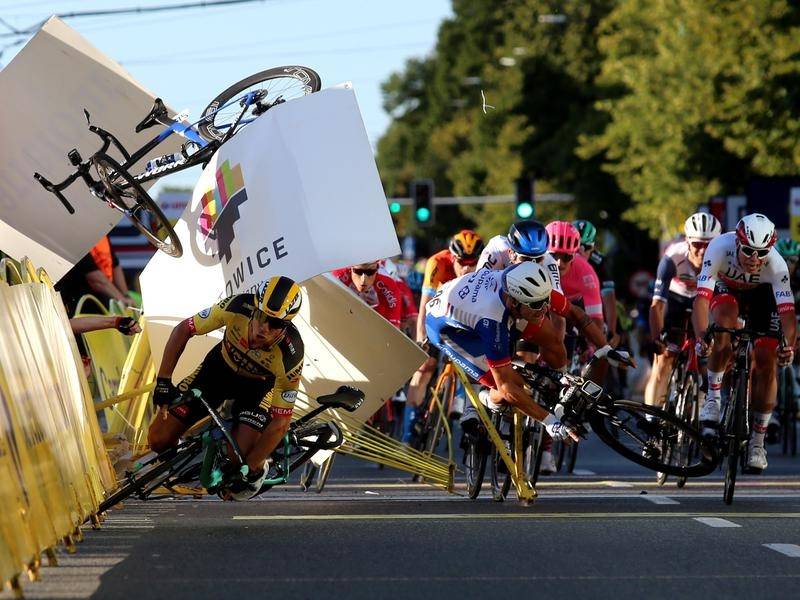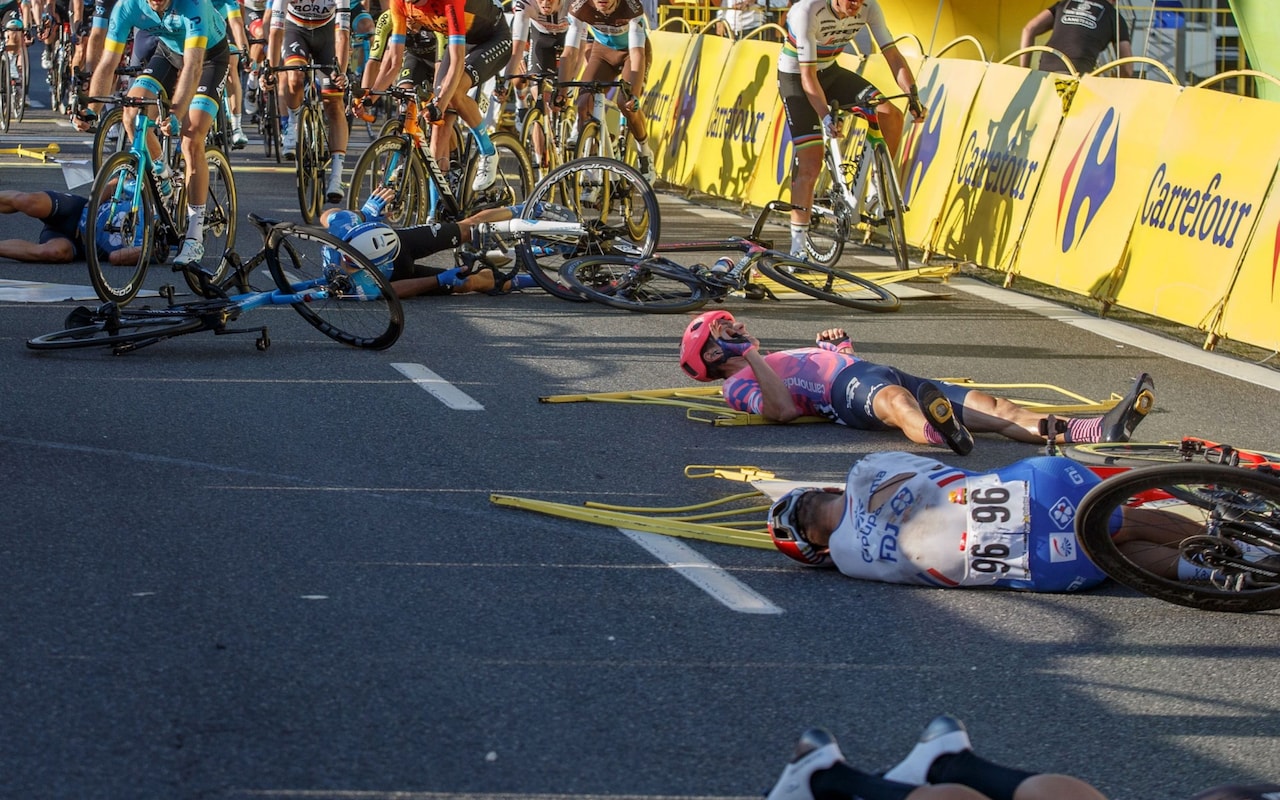There have been an AWFUL lot of crashes in the mere couple of weeks since racing resumed – Kruijkswijk out of the Tour, Roglic out of the Dauphine, Jakobsen pole axed in a Polska finale, Remco over a bridge – and we could go on. When we saw this piece on the website of our amigo, ex-World Junior Team Time Trial Champion, Nikolai Razouvaev aka ‘The Russian Crank’ we thought he made some interesting points.
But before you read what Nikolai says…
I bought a book the other day; from The Yellow Jersey Press, ‘The Secret Cyclist – real life in the professional peloton’ by an anonymous professional rider.
His view of Richie Porte’s 2017 Tour stack;
“Porte can be as fast uphill as they want, but if they can’t handle tricky little roads, fast descents, and difficult surfaces like gravel or cobbles, you don’t deserve to win a Grand Tour.
“We’re not racing on Strava, or on exercise bikes in the gym.
“Cycling is supposed to be hardcore.”
And whilst I’m a huge Remco and Deceuninck fan, everyone else in that lead group DID get round that bend in Lombardy…
Over to you, Nikolai:
* * *
Bike crashes hurt.
To paraphrase ‘Fight Club’s’ Tyler Durden, on a long enough timeline, the crash-free rate drops to zero.
It’s the law.
Philippe Gilbert, quoted by VeloNews, said as much:
“I have already ridden more than 1,000 races in my career and there was perhaps only one without a crash.”
Philippe knows what he’s talking about.

Sitting in front of a TV watching a pro race, it puzzles me why these skilled professionals crash so much.
It puzzles me because when I look back at my time racing in Soviet Union, I remember crashes.
Big crashes, small crashes, nasty, bloody crashes, and one-offs when someone slides on a corner without taking anyone with him.
It happened but not at a rate I see on TV in professional racing. We didn’t crash that much. I could go an entire season without a crash. Many of my teammates did too.
Skill? Not it. A pro rider is a pro rider.
Before reaching that level, the pros spend years in the saddle, thousands of hours. Racing in all conditions. Sun, rain, sleet. Snow even. Good roads, bad roads. Cities, open roads. You name it, they raced it.
Not skill.
I would be an idiot pretending the Eastern Bloc system bred better-skilled racers. This is stupid.
Commentators, those who know what they’re talking about and those who don’t, like to mention road furniture. They have a point. When the guys in front of you split left and right and a traffic dome pops in your face at 50km/h, you go down. Hard.
Road furniture doesn’t explain all crashes though. Not even half. Maybe 10%? Who knows? I don’t. It’s a problem but not the problem.
In the USSR, road engineers didn’t care about road furniture as much as the Western engineers did. Different priorities I guess. Road furniture didn’t bother us, we had to deal with something worse — potholes and traffic.
In the road furniture v’s potholes contest (the Soviet roads’ potholes), the potholes win. In my opinion anyway.
They win because the ratio is about 20 to 1 — 20 potholes v’s 1 piece of road furniture. The potholes win because one out of 10 of those potholes could swallow a truck and if you hit it at full speed, not only will you say goodbye to your wheels and possibly the frame, but maybe your face too as you know it.
Breaking a collarbone would be like hitting a jackpot. Your lucky day, pal.
And then traffic.
Road closures? What road closures?
“You’re telling us you want to run a bike race and shut down road traffic?
“We don’t think so.
“What is this, the Olympic Games or something?”
The organizers used a rolling road closure. So called.
They’d send a copper in front of the peloton and he’d order upcoming cars and trucks to get off the road. Some, only some, seeing something is going on would stay put and wait for the peloton to pass. Others would take off as soon as the cop swished by and kept driving.
If the peloton, because of where the wind was coming from, rode in the left lane or took over the two lanes, you’d be looking, if you saw it, at a car or a truck charging toward you.
Picture a peloton shrinking to one side of the road as if a bomb blew up next to it and the commissar’s car trying to stop the missile with flashing headlights, honking and gesticulating hands from the window.It worked, somehow.
A lot of things in Soviet Union that were not supposed to work, somehow worked. Most of the time.
And those parked cars on the side of the road.
Good citizens parked on the shoulder, if there was one, but most swerved a meter or two off the road and thought they gave us enough space to squeeze by.
Picture a crosswind, a typical feature of most road races in the Soviet Union. It’s hammer down from the gun and before you know it, you’re in a string, eyeballs out trying to hang on with the first echelon.
Those eyeballs, you focus them on the rear wheel in front of you. Not so much on a wheel but on the tire because you want to stick to it without touching it. You can’t see shit in front of you.
It’s just the tire and everything else, the world to your left and to your right, the tarmac below, it’s all blurred. You want that tire. You want the road to change direction. You want more slipstream. And then you see that wheel lean to the side. Sharp.
A swing. And like a fish pierced by a spear, you swing too. You have to because if he swings and you don’t, or you’re too slow to react, you hit a parked car. You know this because you see that car a split second later as you pass it.
This corrida never stops as long as the wind blows from the side and the hammer is down. You’re on a knife’s edge saving your ass from a shit result and from breaking your bones, all in one package.
And yet, no one hits anything.
Skill and experience, sure, it helps. In junior races, I’ve seen people hanging their front wheel on someone’s rear derailleur and going down when they didn’t react on time but at the high end of the hierarchy, this was rare. You learn.
You learn with your own skin and by the time you reach the big boys’ league, you learn to trust the wheel in front of you. It’s not a ticket to a life without crashes, but what else can you do riding blind when the bets are off and you have nowhere to hide from the wind? Follow the wheel.
He swings, you swing. It’s how it goes. The shit pro riders in Europe have to deal with to stay upright is real. The road furniture, the foul play in the sprints, the stupid barriers the organisers erect without thinking, all of these things take riders down, but there’s more to it.

One other reason they crash so much is the aero wheels. These darlings of bike manufacturing wobble your bike in the wind. The stronger the wind, coming from the side, the more your bike wobbles. It’s physics. Nothing you can do about it.
I get it. The deep-section wheels give you extra speed, okay. Simple enough. But they also throw you around when a gust of wind hits that tall rim from the side. And when it does, you jerk. It’s a sail, that’s what it is.
And when you jerk, you may or may not stay upright. It depends. At this point, it’s mathematics.
The more riders get hit with a gust of wind, the more chances of at least one of them losing their shit and going down. It’s that Tyler Durden’s maxim again, reversed. On a long enough timeline of crosswinds, the rate of crashes goes up as long as the wind hits enough sails that also act as wheels.
To be fair, I don’t see as many 80mm wheels in a pro peloton as I used to see in the past. I guess the riders have wised up. The danger of these wheels outweighed the speed gain for them. Not worth it.
And by the way, it’s not just the wind that causes trouble for deep-section wheels. If you own an old-school, 32 or 36 spoke wheel and deep-section wheels, try this. Grab an old-school wheel, hold it by the skewers and spin it as hard as you can. Lean it left and right and notice how hard it is to do it.
Then do the same with a deep-section wheel. You’ll see it’s harder to lean the deep-section wheel. I have no idea what causes this effect. I suck at physics.
All I know, from riding, the faster the speed, the harder it is to change direction on deep-section wheels. And the deeper the rim, the stronger the effect.
This may explain riders stuffing up corners on fast descends. If you watch enough pro racing, you see the stuff-ups all the time. They stuff it up again and again for no obvious reason. Guys with 10 plus years of racing in the bag. It’s just bizarre. Rim brakes, disc brakes, it doesn’t matter.
They go too wide and then either fix the problem at the last moment or hit the rails when it’s too late to fix it.
As an ex-racer, it hurts me to watch it.

I don’t have a solution for this.
I don’t even know if what I’m talking about is true. It’s me talking out loud with you. If this is true, what is a safe rim’s depth for professional racing? 30mm? 40? 50? I don’t know.
If we had an F1-like governing body that cared for riders’ safety, which we don’t, they’d test these things to death before letting them experiment and throw their careers, and sometimes lives, at these experiments.
Until then, the bloodbath will go on.
Check out Nikolai Razouvaev’s site for more thoughts on bike racing.



